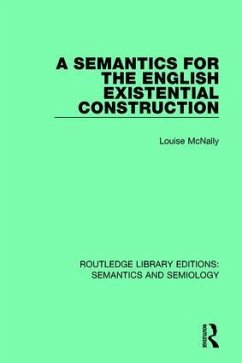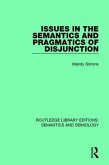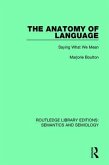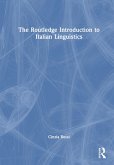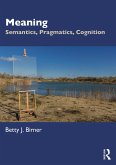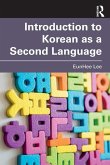Louise McNally
A Semantics for the English Existential Construction
Louise McNally
A Semantics for the English Existential Construction
- Broschiertes Buch
- Merkliste
- Auf die Merkliste
- Bewerten Bewerten
- Teilen
- Produkt teilen
- Produkterinnerung
- Produkterinnerung
First published in 1997, this book addresses the question: What is the interpretation of English there-existential construction? One of the principal goals is to develop an interpretation for the construction that will specifically address other properties of the postcopular DP. This book will be of interest to students of linguistics.
Andere Kunden interessierten sich auch für
![Issues in the Semantics and Pragmatics of Disjunction Issues in the Semantics and Pragmatics of Disjunction]() Mandy SimonsIssues in the Semantics and Pragmatics of Disjunction43,99 €
Mandy SimonsIssues in the Semantics and Pragmatics of Disjunction43,99 €![The Anatomy of Language The Anatomy of Language]() Marjorie BoultonThe Anatomy of Language61,99 €
Marjorie BoultonThe Anatomy of Language61,99 €![The Routledge Introduction to Italian Linguistics The Routledge Introduction to Italian Linguistics]() Cinzia RussiThe Routledge Introduction to Italian Linguistics176,99 €
Cinzia RussiThe Routledge Introduction to Italian Linguistics176,99 €![Meaning Meaning]() Betty J. Birner (USA Northern Illinois University)Meaning56,99 €
Betty J. Birner (USA Northern Illinois University)Meaning56,99 €![When Death Enters the Therapeutic Space When Death Enters the Therapeutic Space]() Laura Barnett (ed.)When Death Enters the Therapeutic Space53,99 €
Laura Barnett (ed.)When Death Enters the Therapeutic Space53,99 €![Introduction to Korean as a Second Language Introduction to Korean as a Second Language]() EunHee Lee (USA University at Buffalo)Introduction to Korean as a Second Language59,99 €
EunHee Lee (USA University at Buffalo)Introduction to Korean as a Second Language59,99 €![The Existential Leader The Existential Leader]() Monica HanawayThe Existential Leader44,99 €
Monica HanawayThe Existential Leader44,99 €-
-
-
First published in 1997, this book addresses the question: What is the interpretation of English there-existential construction? One of the principal goals is to develop an interpretation for the construction that will specifically address other properties of the postcopular DP. This book will be of interest to students of linguistics.
Hinweis: Dieser Artikel kann nur an eine deutsche Lieferadresse ausgeliefert werden.
Hinweis: Dieser Artikel kann nur an eine deutsche Lieferadresse ausgeliefert werden.
Produktdetails
- Produktdetails
- Routledge Library Editions: Semantics and Semiology
- Verlag: Taylor & Francis Ltd
- Seitenzahl: 222
- Erscheinungstermin: 16. Februar 2018
- Englisch
- Abmessung: 156mm x 234mm x 16mm
- Gewicht: 368g
- ISBN-13: 9781138690882
- ISBN-10: 1138690880
- Artikelnr.: 52638877
- Herstellerkennzeichnung
- Libri GmbH
- Europaallee 1
- 36244 Bad Hersfeld
- gpsr@libri.de
- Routledge Library Editions: Semantics and Semiology
- Verlag: Taylor & Francis Ltd
- Seitenzahl: 222
- Erscheinungstermin: 16. Februar 2018
- Englisch
- Abmessung: 156mm x 234mm x 16mm
- Gewicht: 368g
- ISBN-13: 9781138690882
- ISBN-10: 1138690880
- Artikelnr.: 52638877
- Herstellerkennzeichnung
- Libri GmbH
- Europaallee 1
- 36244 Bad Hersfeld
- gpsr@libri.de
Louise McNally
1 The Problem; 1.1 Introduction 1.2 Facts of be Accounted For 1.2.1 The
Definiteness Effect 1.2.2 The Predicate Restriction 1.3 Previous Analyses
1.3.1 There-Insertion and Its Descendants 1.3.2 Previous Characterizations
of the DE 1.3.3 The Predicate Restriction 1.4 Outline of Remaining
Chapters; 2 Existential Syntax; 2.1 Introduction 2.2 Identifying
VP-Adjuncts 2.2.1 Description 2.2.2 A Proposal for Depictive Adjuncts 2.3
Why a DP-External XP Must Be Posited 2.3.1 Arguments for Independence 2.3.2
Williams' Counterarguments 2.4 Supporting the Adjunct Analysis 2.4.1
Stowell's Small clause Diagnostics 2.4.2 Extraction 2.5 Chapter Summary; 3
The Existential, Descriptions, and Instantiation; 3.1 Introduction 3.2 Data
to Be Accounted For 3.2.1 Quantificational DPs 3.2.2 Scope 3.2.3 Contact
Clauses 3.2.4 Relative Clauses 3.3 Property Theory 3.3.1 The Syntax of PT
3.3.2 The Interpretation of PT 3.4 Interpreting the Existential 3.4.1 A
Dynamic PT Fragment of English 3.4.2 Interpreting Existential Sentences 3.5
Definites and the Other Half of the DE 3.5.1 Augmenting the Fragment 3.5.2
A Felicity Condition on Existentials 3.5.3 Summary 3.6 Advantages of the
Analysis 3.6.1 Acceptability of Quantified Kind DPs 3.6.2 Quantification
and Scope 3.6.3 Contact Clauses 3.6.4 Relativization 3.6.5 Summary; 4
Adjunct Predicates and the Predicate Restriction; 4.1 Introduction 4.2
Interpreting Depictive Adjuncts 4.2.1 The Adjunct Rule 4.2.2
Individual/Stage Sensitivity 4.3 Extending the Analysis 4.3.1 Nominalized
Functions as Controllers 4.3.2 The Predicate Restriction Revisited 4.4
Eventive Existentials 4.4.1 The Problem 4.4.2 Eventive Participles 4.4.3
Why These Existentials Are Not Passives 4.4.4 A Proposal 4.5 Chapter
Summary; 5 Some Final Remarks; 5.1 Introduction 5.2 Definites in the
Existential 5.2.1 List Existentials 5.2.2 Focus and Existential 5.3 Other
Expectations 5.3.1 Other Expletive There Sentences 5.3.2 The Existential
and Other Indexicals; References; Index
Definiteness Effect 1.2.2 The Predicate Restriction 1.3 Previous Analyses
1.3.1 There-Insertion and Its Descendants 1.3.2 Previous Characterizations
of the DE 1.3.3 The Predicate Restriction 1.4 Outline of Remaining
Chapters; 2 Existential Syntax; 2.1 Introduction 2.2 Identifying
VP-Adjuncts 2.2.1 Description 2.2.2 A Proposal for Depictive Adjuncts 2.3
Why a DP-External XP Must Be Posited 2.3.1 Arguments for Independence 2.3.2
Williams' Counterarguments 2.4 Supporting the Adjunct Analysis 2.4.1
Stowell's Small clause Diagnostics 2.4.2 Extraction 2.5 Chapter Summary; 3
The Existential, Descriptions, and Instantiation; 3.1 Introduction 3.2 Data
to Be Accounted For 3.2.1 Quantificational DPs 3.2.2 Scope 3.2.3 Contact
Clauses 3.2.4 Relative Clauses 3.3 Property Theory 3.3.1 The Syntax of PT
3.3.2 The Interpretation of PT 3.4 Interpreting the Existential 3.4.1 A
Dynamic PT Fragment of English 3.4.2 Interpreting Existential Sentences 3.5
Definites and the Other Half of the DE 3.5.1 Augmenting the Fragment 3.5.2
A Felicity Condition on Existentials 3.5.3 Summary 3.6 Advantages of the
Analysis 3.6.1 Acceptability of Quantified Kind DPs 3.6.2 Quantification
and Scope 3.6.3 Contact Clauses 3.6.4 Relativization 3.6.5 Summary; 4
Adjunct Predicates and the Predicate Restriction; 4.1 Introduction 4.2
Interpreting Depictive Adjuncts 4.2.1 The Adjunct Rule 4.2.2
Individual/Stage Sensitivity 4.3 Extending the Analysis 4.3.1 Nominalized
Functions as Controllers 4.3.2 The Predicate Restriction Revisited 4.4
Eventive Existentials 4.4.1 The Problem 4.4.2 Eventive Participles 4.4.3
Why These Existentials Are Not Passives 4.4.4 A Proposal 4.5 Chapter
Summary; 5 Some Final Remarks; 5.1 Introduction 5.2 Definites in the
Existential 5.2.1 List Existentials 5.2.2 Focus and Existential 5.3 Other
Expectations 5.3.1 Other Expletive There Sentences 5.3.2 The Existential
and Other Indexicals; References; Index
1 The Problem; 1.1 Introduction 1.2 Facts of be Accounted For 1.2.1 The
Definiteness Effect 1.2.2 The Predicate Restriction 1.3 Previous Analyses
1.3.1 There-Insertion and Its Descendants 1.3.2 Previous Characterizations
of the DE 1.3.3 The Predicate Restriction 1.4 Outline of Remaining
Chapters; 2 Existential Syntax; 2.1 Introduction 2.2 Identifying
VP-Adjuncts 2.2.1 Description 2.2.2 A Proposal for Depictive Adjuncts 2.3
Why a DP-External XP Must Be Posited 2.3.1 Arguments for Independence 2.3.2
Williams' Counterarguments 2.4 Supporting the Adjunct Analysis 2.4.1
Stowell's Small clause Diagnostics 2.4.2 Extraction 2.5 Chapter Summary; 3
The Existential, Descriptions, and Instantiation; 3.1 Introduction 3.2 Data
to Be Accounted For 3.2.1 Quantificational DPs 3.2.2 Scope 3.2.3 Contact
Clauses 3.2.4 Relative Clauses 3.3 Property Theory 3.3.1 The Syntax of PT
3.3.2 The Interpretation of PT 3.4 Interpreting the Existential 3.4.1 A
Dynamic PT Fragment of English 3.4.2 Interpreting Existential Sentences 3.5
Definites and the Other Half of the DE 3.5.1 Augmenting the Fragment 3.5.2
A Felicity Condition on Existentials 3.5.3 Summary 3.6 Advantages of the
Analysis 3.6.1 Acceptability of Quantified Kind DPs 3.6.2 Quantification
and Scope 3.6.3 Contact Clauses 3.6.4 Relativization 3.6.5 Summary; 4
Adjunct Predicates and the Predicate Restriction; 4.1 Introduction 4.2
Interpreting Depictive Adjuncts 4.2.1 The Adjunct Rule 4.2.2
Individual/Stage Sensitivity 4.3 Extending the Analysis 4.3.1 Nominalized
Functions as Controllers 4.3.2 The Predicate Restriction Revisited 4.4
Eventive Existentials 4.4.1 The Problem 4.4.2 Eventive Participles 4.4.3
Why These Existentials Are Not Passives 4.4.4 A Proposal 4.5 Chapter
Summary; 5 Some Final Remarks; 5.1 Introduction 5.2 Definites in the
Existential 5.2.1 List Existentials 5.2.2 Focus and Existential 5.3 Other
Expectations 5.3.1 Other Expletive There Sentences 5.3.2 The Existential
and Other Indexicals; References; Index
Definiteness Effect 1.2.2 The Predicate Restriction 1.3 Previous Analyses
1.3.1 There-Insertion and Its Descendants 1.3.2 Previous Characterizations
of the DE 1.3.3 The Predicate Restriction 1.4 Outline of Remaining
Chapters; 2 Existential Syntax; 2.1 Introduction 2.2 Identifying
VP-Adjuncts 2.2.1 Description 2.2.2 A Proposal for Depictive Adjuncts 2.3
Why a DP-External XP Must Be Posited 2.3.1 Arguments for Independence 2.3.2
Williams' Counterarguments 2.4 Supporting the Adjunct Analysis 2.4.1
Stowell's Small clause Diagnostics 2.4.2 Extraction 2.5 Chapter Summary; 3
The Existential, Descriptions, and Instantiation; 3.1 Introduction 3.2 Data
to Be Accounted For 3.2.1 Quantificational DPs 3.2.2 Scope 3.2.3 Contact
Clauses 3.2.4 Relative Clauses 3.3 Property Theory 3.3.1 The Syntax of PT
3.3.2 The Interpretation of PT 3.4 Interpreting the Existential 3.4.1 A
Dynamic PT Fragment of English 3.4.2 Interpreting Existential Sentences 3.5
Definites and the Other Half of the DE 3.5.1 Augmenting the Fragment 3.5.2
A Felicity Condition on Existentials 3.5.3 Summary 3.6 Advantages of the
Analysis 3.6.1 Acceptability of Quantified Kind DPs 3.6.2 Quantification
and Scope 3.6.3 Contact Clauses 3.6.4 Relativization 3.6.5 Summary; 4
Adjunct Predicates and the Predicate Restriction; 4.1 Introduction 4.2
Interpreting Depictive Adjuncts 4.2.1 The Adjunct Rule 4.2.2
Individual/Stage Sensitivity 4.3 Extending the Analysis 4.3.1 Nominalized
Functions as Controllers 4.3.2 The Predicate Restriction Revisited 4.4
Eventive Existentials 4.4.1 The Problem 4.4.2 Eventive Participles 4.4.3
Why These Existentials Are Not Passives 4.4.4 A Proposal 4.5 Chapter
Summary; 5 Some Final Remarks; 5.1 Introduction 5.2 Definites in the
Existential 5.2.1 List Existentials 5.2.2 Focus and Existential 5.3 Other
Expectations 5.3.1 Other Expletive There Sentences 5.3.2 The Existential
and Other Indexicals; References; Index

